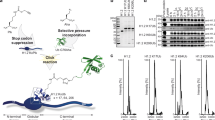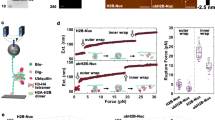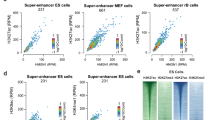Abstract
Regulation of chromatin structure involves histone posttranslational modifications that can modulate intrinsic properties of the chromatin fiber to change the chromatin state. We used chemically defined nucleosome arrays to demonstrate that H2B ubiquitylation (uH2B), a modification associated with transcription, interferes with chromatin compaction and leads to an open and biochemically accessible fiber conformation. Notably, these effects were specific for ubiquitin, as compaction of chromatin modified with a similar ubiquitin-sized protein, Hub1, was only weakly affected. Applying a fluorescence-based method, we found that uH2B acts through a mechanism distinct from H4 tail acetylation, a modification known to disrupt chromatin folding. Finally, incorporation of both uH2B and acetylated H4 resulted in synergistic inhibition of higher-order chromatin structure formation, possibly a result of their distinct modes of action.
This is a preview of subscription content, access via your institution
Access options
Subscribe to this journal
Receive 12 print issues and online access
$259.00 per year
only $21.58 per issue
Buy this article
- Purchase on Springer Link
- Instant access to full article PDF
Prices may be subject to local taxes which are calculated during checkout





Similar content being viewed by others
References
Cui, Y. & Bustamante, C. Pulling a single chromatin fiber reveals the forces that maintain its higher-order structure. Proc. Natl. Acad. Sci. USA 97, 127–132 (2000).
Poirier, M.G., Bussiek, M., Langowski, J. & Widom, J. Spontaneous access to DNA target sites in folded chromatin fibers. J. Mol. Biol. 379, 772–786 (2008).
Kruithof, M. et al. Single-molecule force spectroscopy reveals a highly compliant helical folding for the 30-nm chromatin fiber. Nat. Struct. Mol. Biol. 16, 534–540 (2009).
Poirier, M.G., Oh, E., Tims, H.S. & Widom, J. Dynamics and function of compact nucleosome arrays. Nat. Struct. Mol. Biol. 16, 938–944 (2009).
Hansen, J.C. Conformational dynamics of the chromatin fiber in solution: determinants, mechanisms, and functions. Annu. Rev. Biophys. Biomol. Struct. 31, 361–392 (2002).
Luger, K., Mader, A.W., Richmond, R.K., Sargent, D.F. & Richmond, T.J. Crystal structure of the nucleosome core particle at 2.8 A resolution. Nature 389, 251–260 (1997).
Dorigo, B., Schalch, T., Bystricky, K. & Richmond, T.J. Chromatin fiber folding: requirement for the histone H4 N-terminal tail. J. Mol. Biol. 327, 85–96 (2003).
Chodaparambil, J.V. et al. A charged and contoured surface on the nucleosome regulates chromatin compaction. Nat. Struct. Mol. Biol. 14, 1105–1107 (2007).
Schalch, T., Duda, S., Sargent, D.F. & Richmond, T.J. X-ray structure of a tetranucleosome and its implications for the chromatin fibre. Nature 436, 138–141 (2005).
Strahl, B.D. & Allis, C.D. The language of covalent histone modifications. Nature 403, 41–45 (2000).
Shogren-Knaak, M. et al. Histone H4–K16 acetylation controls chromatin structure and protein interactions. Science 311, 844–847 (2006).
Robinson, P.J. et al. 30 nm chromatin fibre decompaction requires both H4–K16 acetylation and linker histone eviction. J. Mol. Biol. 381, 816–825 (2008).
Hilfiker, A., Hilfiker-Kleiner, D., Pannuti, A. & Lucchesi, J.C. mof, a putative acetyl transferase gene related to the Tip60 and MOZ human genes and to the SAS genes of yeast, is required for dosage compensation in Drosophila. EMBO J. 16, 2054–2060 (1997).
West, M.H. & Bonner, W.M. Histone 2B can be modified by the attachment of ubiquitin. Nucleic Acids Res. 8, 4671–4680 (1980).
Xiao, T. et al. Histone H2B ubiquitylation is associated with elongating RNA polymerase II. Mol. Cell. Biol. 25, 637–651 (2005).
Minsky, N. et al. Monoubiquitinated H2B is associated with the transcribed region of highly expressed genes in human cells. Nat. Cell Biol. 10, 483–488 (2008).
Kim, J. et al. RAD6-Mediated transcription-coupled H2B ubiquitylation directly stimulates H3K4 methylation in human cells. Cell 137, 459–471 (2009).
Zhu, B. et al. Monoubiquitination of human histone H2B: the factors involved and their roles in HOX gene regulation. Mol. Cell 20, 601–611 (2005).
Shema, E. et al. The histone H2B-specific ubiquitin ligase RNF20/hBRE1 acts as a putative tumor suppressor through selective regulation of gene expression. Genes Dev. 22, 2664–2676 (2008).
Chandrasekharan, M.B., Huang, F. & Sun, Z.W. Ubiquitination of histone H2B regulates chromatin dynamics by enhancing nucleosome stability. Proc. Natl. Acad. Sci. USA 106, 16686–16691 (2009).
Pavri, R. et al. Histone H2B monoubiquitination functions cooperatively with FACT to regulate elongation by RNA polymerase II. Cell 125, 703–717 (2006).
Fleming, A.B., Kao, C.F., Hillyer, C., Pikaart, M. & Osley, M.A. H2B ubiquitylation plays a role in nucleosome dynamics during transcription elongation. Mol. Cell 31, 57–66 (2008).
Robzyk, K., Recht, J. & Osley, M.A. Rad6-dependent ubiquitination of histone H2B in yeast. Science 287, 501–504 (2000).
Sun, Z.W. & Allis, C.D. Ubiquitination of histone H2B regulates H3 methylation and gene silencing in yeast. Nature 418, 104–108 (2002).
Sridhar, V.V. et al. Control of DNA methylation and heterochromatic silencing by histone H2B deubiquitination. Nature 447, 735–738 (2007).
Chatterjee, C., McGinty, R.K., Fierz, B. & Muir, T.W. Disulfide directed histone ubiquitylation reveals plasticity in hDot1L stimulation. Nat. Chem. Biol. 6, 267–269 (2010).
Lowary, P.T. & Widom, J. New DNA sequence rules for high affinity binding to histone octamer and sequence-directed nucleosome positioning. J. Mol. Biol. 276, 19–42 (1998).
McGinty, R.K., Kim, J., Chatterjee, C., Roeder, R.G. & Muir, T.W. Chemically ubiquitylated histone H2B stimulates hDot1L-mediated intranucleosomal methylation. Nature 453, 812–816 (2008).
Henikoff, S., Henikoff, J.G., Sakai, A., Loeb, G.B. & Ahmad, K. Genome-wide profiling of salt fractions maps physical properties of chromatin. Genome Res. 19, 460–469 (2009).
Nickel, B.E., Allis, C.D. & Davie, J.R. Ubiquitinated histone H2B is preferentially located in transcriptionally active chromatin. Biochemistry 28, 958–963 (1989).
Delcuve, G.P. & Davie, J.R. Chromatin structure of erythroid-specific genes of immature and mature chicken erythrocytes. Biochem. J. 263, 179–186 (1989).
Runnels, L.W. & Scarlata, S.F. Theory and application of fluorescence homotransfer to melittin oligomerization. Biophys. J. 69, 1569–1583 (1995).
Bergström, F., Hagglof, P., Karolin, J., Ny, T. & Johansson, L.B. The use of site-directed fluorophore labeling and donor-donor energy migration to investigate solution structure and dynamics in proteins. Proc. Natl. Acad. Sci. USA 96, 12477–12481 (1999).
Gautier, I. et al. Homo-FRET microscopy in living cells to measure monomer-dimer transition of GFP-tagged proteins. Biophys. J. 80, 3000–3008 (2001).
Thaler, C., Koushik, S.V., Puhl, H.L. III, Blank, P.S. & Vogel, S.S. Structural rearrangement of CaMKIIalpha catalytic domains encodes activation. Proc. Natl. Acad. Sci. USA 106, 6369–6374 (2009).
Kawski, A. Excitation energy transfer and its manifestation in isotropic media. Photochem. Photobiol. 38, 487–508 (1983).
Woodcock, C.L., Grigoryev, S.A., Horowitz, R.A. & Whitaker, N. A chromatin folding model that incorporates linker variability generates fibers resembling the native structures. Proc. Natl. Acad. Sci. USA 90, 9021–9025 (1993).
Knox, R. Theory of polarization quenching by excitation transfer. Physica 39, 361–386 (1968).
Woodcock, C.L. & Horowitz, R.A. Chromatin organization re-viewed. Trends Cell Biol. 5, 272–277 (1995).
Kurdistani, S.K., Tavazoie, S. & Grunstein, M. Mapping global histone acetylation patterns to gene expression. Cell 117, 721–733 (2004).
Koch, C.M. et al. The landscape of histone modifications across 1% of the human genome in five human cell lines. Genome Res. 17, 691–707 (2007).
Dittmar, G.A., Wilkinson, C.R., Jedrzejewski, P.T. & Finley, D. Role of a ubiquitin-like modification in polarized morphogenesis. Science 295, 2442–2446 (2002).
Taverna, S.D., Li, H., Ruthenburg, A.J., Allis, C.D. & Patel, D.J. How chromatin-binding modules interpret histone modifications: lessons from professional pocket pickers. Nat. Struct. Mol. Biol. 14, 1025–1040 (2007).
Lu, X. et al. The effect of H3K79 dimethylation and H4K20 trimethylation on nucleosome and chromatin structure. Nat. Struct. Mol. Biol. 15, 1122–1124 (2008).
Jason, L.J.M., Moore, S.C., Ausio, J. & Lindsey, G. Magnesium-dependent association and folding of oligonucleosomes reconstituted with ubiquitinated H2A. J. Biol. Chem. 276, 14597–14601 (2001).
Demeler, B. UltraScan version 9.9 rev 863. A Comprehensive Data Analysis Software Package for Analytical Ultracentrifugation Experiments (http://www.ultrascan.uthscsa.edu, The University of Texas Health Science Center at San Antonio, Department of Biochemistry, 2009).
Demeler, B. & van Holde, K.E. Sedimentation velocity analysis of highly heterogeneous systems. Anal. Biochem. 335, 279–288 (2004).
McGinty, R.K. et al. Structure activity analysis of semisynthetic nucleosomes: Mechanistic insights into the stimulation of Dot1L by ubiquitylated histone H2B. ACS Chem. Biol. 4, 958–968 (2009).
Vijay-Kumar, S., Bugg, C.E. & Cook, W.J. Structure of ubiquitin refined at 1.8 A resolution. J. Mol. Biol. 194, 531–544 (1987).
Ramelot, T.A. et al. Solution structure of the yeast ubiquitin-like modifier protein Hub1. J. Struct. Funct. Genomics 4, 25–30 (2003).
Acknowledgements
We thank H. Deng and H. Yu (The Rockefeller University) for mass spectrometric analysis of histones, J. Kim and R. Subramanian for assistance with preparing hDot1L, K. Chiang for help with DNA preparation, H. Yang and D. Montiel for help with fluorescence lifetime measurements and A. Ruthenburg, R. Sadeh, P. Moyle and M. Vila-Perelló for assistance with cell experiments and discussions. This work was funded by the US National Institutes of Health (grant number RC2CA148354) and the Starr Cancer Consortium. B.F. was funded by the Swiss National Science Foundation (Nr. PBBSA-118839 and PA00P3_129130/1) and by the Novartis Foundation.
Author information
Authors and Affiliations
Contributions
B.F. and T.W.M. designed the experiments. B.F. performed the biophysical chromatin experiments. B.F. and C.C. performed the methyltransferase assays and cell experiments. B.F., C.C., R.K.M. and M.B.-D. prepared new reagents. B.F., D.P.R. and T.W.M. analyzed the experimental data, and B.F. and T.W.M. wrote the paper.
Corresponding author
Ethics declarations
Competing interests
The authors declare no competing financial interests.
Supplementary information
Supplementary Text and Figures
Supplementary Methods and Supplementary Figures 1–11 (PDF 1538 kb)
Rights and permissions
About this article
Cite this article
Fierz, B., Chatterjee, C., McGinty, R. et al. Histone H2B ubiquitylation disrupts local and higher-order chromatin compaction. Nat Chem Biol 7, 113–119 (2011). https://doi.org/10.1038/nchembio.501
Received:
Accepted:
Published:
Issue Date:
DOI: https://doi.org/10.1038/nchembio.501
This article is cited by
-
RNA modification: mechanisms and therapeutic targets
Molecular Biomedicine (2023)
-
H2B ubiquitination recruits FACT to maintain a stable altered nucleosome state for transcriptional activation
Nature Communications (2023)
-
HSF1 phosphorylation establishes an active chromatin state via the TRRAP–TIP60 complex and promotes tumorigenesis
Nature Communications (2022)
-
New insights into the mechanism of RPA in preserving genome stability
Genome Instability & Disease (2022)
-
Multifaceted roles of YEATS domain-containing proteins and novel links to neurological diseases
Cellular and Molecular Life Sciences (2022)



